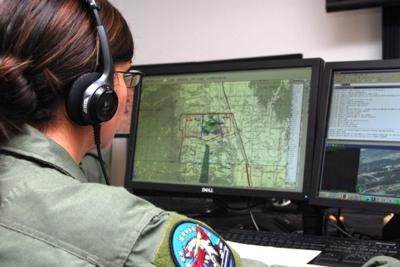Fri, Aug 03, 2012
Program Started In 2009
Cadets participating in Expeditionary Survival and Evasion Training aren't alone. Throughout the day, winged guardians watch over them, protecting them from harm.

The guardians are Aerosonde Mark IV remotely piloted aircraft, operated by cadet pilots in the 557th Flying Training Squadron facility adjacent to the Academy Airfield. The setup there, with stations and monitors set up to resemble the Combined Air and Space Operations Center in Southwest Asia, symbolizes how far the Academy's unmanned aerial system program has evolved in the three years since it started in 2009.
"In the history of the Academy, we've talked about airpower, doctrine and the strategy of how air assets work in a tactical environment," said Lt. Col. John McCurdy, who directs the summer airmanship program. "This is truly game-changer for the Academy. We're not just teaching cadets how to fly the aircraft -- the real value is bringing in the airpower component to their education."
The UAS program started in 2009 with a pair of Viking 300 aircraft and a dirt runway at Camp Red Devil on Fort Carson, CO, and focused on flight training and familiarization. Today's UAS program goes well beyond that, said Cadet 1st Class Rusty Thomas, who has taken summer UAS courses since 2010. "I've seen the program change a lot," said Thomas, who is assigned to Cadet Squadron 04. "The scenarios are a lot more realistic, especially working with ESET. If we'd had this my freshman year, it would have been really cool."
Over the years, both cadet instructor pilots and permanent-party staff have contributed to the program's operational feel, Thomas said. Today, cadet UAS instructor pilots work with the ESET joint operations center to support cadets in the field, relaying their taskings via an isolated, fiber-optic network to the air operations center at the airfield. There, cadets determine how best to support their on-ground classmates.
Three cadets operate each Aerosonde: one pilot, one sensor operator and one mission commander, who takes some of the duties normally carried out by the pilot in an operational environment. They communicate over channels using nine-line combat support requests and Internet relay chat, mirroring the operational Air Force environment.
Cadet 2nd Class Derek Richardson of CS 15 is also involved with the summer UAS program. The prior-enlisted Airman favorably compared the Academy's program to what he saw during his Operation Air Force visit to Beale Air Force Base, CA, earlier this summer. "A lot of the stuff we learn her correlates directly to how they operate the Global Hawk," he said.
McCurdy said Air Education and Training Command is scheduled to take over the program in the summer of 2014.
(Photo provided by the USAF)
More News
States That Current Process is Damaging National Aerospace Development US Senator Jerry Morgan is pushing the FAA to speed up the process for rocket launch licensing. He argues tha>[...]
From 2015 (YouTube Edition): Model Aviator Aims For Full-Scale Career While at the 2015 Indoor Electric RC Festival, referred to as eFest, ANN CEO and Editor-In-Chief, Jim Campbell>[...]
Dave Juwel's Aviation Marketing Stories ITBOA BNITBOB ... what does that mean? It's not gibberish, it's a lengthy acronym for "In The Business Of Aviation ... But Not In The Busine>[...]
Aero Linx: Cardinal Flyers Online The Cardinal Flyers Online Web site was created and is maintained by me, Keith Peterson. My wife Debbie and I have owned a 1976 RG since 1985. Wit>[...]
Clearance Void If Not Off By (Time) Used by ATC to advise an aircraft that the departure release is automatically canceled if takeoff is not made prior to a specified time. The exp>[...]
 Senator Pushes FAA to Accelerate Rocket Launch Licensing
Senator Pushes FAA to Accelerate Rocket Launch Licensing Classic Aero-TV: RJ Gritter - Part of Aviations Bright New Future
Classic Aero-TV: RJ Gritter - Part of Aviations Bright New Future Aero-FAQ: Dave Juwel's Aviation Marketing Stories -- ITBOA BNITBOB
Aero-FAQ: Dave Juwel's Aviation Marketing Stories -- ITBOA BNITBOB ANN's Daily Aero-Linx (10.27.24)
ANN's Daily Aero-Linx (10.27.24) ANN's Daily Aero-Term (10.27.24): Clearance Void If Not Off By (Time)
ANN's Daily Aero-Term (10.27.24): Clearance Void If Not Off By (Time)



